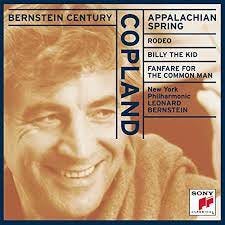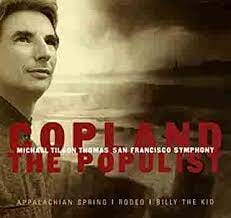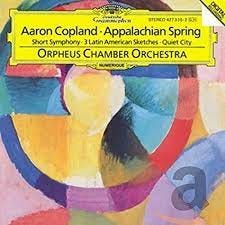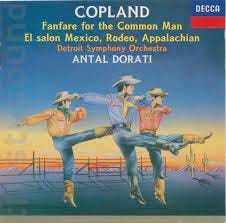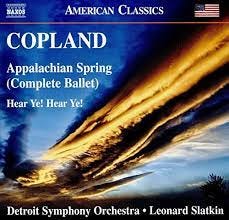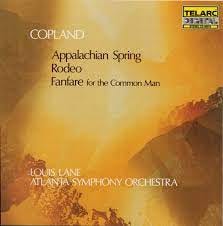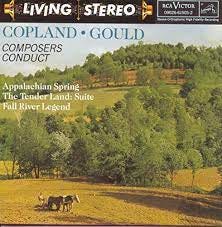41. Copland Conducts Copland
Copland conducts Appalachian Spring, Rodeo, and Fanfare for the Common Man
“The whole problem can be stated quite simply by asking, 'Is there a meaning to music?' My answer would be, 'Yes.' And 'Can you state in so many words what the meaning is?' My answer to that would be, 'No'.”
- Aaron Copland
Moving right along on the way to the top 50 classical recordings of all-time we arrive at an album of the most popular works by American composer Aaron Copland. At #41 in our count is a compilation album titled Copland conducts Copland, which includes perhaps his greatest works together in definitive performances conducted by Copland himself. Included are the works Fanfare for the Common Man, Appalachian Spring, Rodeo: Four Dance Episodes, and Old American Songs (Complete). Recorded by CBS Records (now Sony Classical), these are recordings made between 1962 and 1970 with the London Symphony Orchestra and the Columbia Symphony Orchestra. The Old American Songs feature American baritone William Warfield.
Aaron Copland
Born in Brooklyn, New York in 1900, Aaron Copland looms large as one of the greatest American composers in the history of classical music. A composer of ballet, orchestral, keyboard, vocal, symphonic, film music, concertos, chamber music, band music, and opera genres, Copland occupies a central place in the history of music in the United States, being referred to as “the Dean of American composers”.
Copland was the youngest of five children born to Harris and Sarah Copland, Lithuanian Jewish immigrants who owned a department store in Brooklyn. He took formal piano lessons, but not until age 13, and by that time he had begun dabbling with writing musical pieces.
Foregoing college, Copland began studying music theory and composition and began to attend as many concerts, operas, and ballets as he could. Copland took formal lessons in harmony, theory, and composition from Rubin Goldmark, a noted teacher and composer of American music (who had given George Gershwin three lessons). Goldmark, with whom Copland studied between 1917 and 1921, gave the young Copland a solid foundation, especially in the Germanic tradition. As Copland stated later: "This was a stroke of luck for me. I was spared the floundering that so many musicians have suffered through incompetent teaching." But Copland also commented that the maestro had "little sympathy for the advanced musical idioms of the day" and his "approved" composers ended with Richard Strauss. In 1921, Copland took a giant leap by going to France to take composition and conducting classes in Fontainebleau. Later he would travel to Paris to meet with the famed composition teacher Nadia Boulanger (Boulanger would later say she knew immediately that Copland was very gifted). He soaked up European culture for the next three years. He came to greatly admire composers such as Stravinsky, Milhaud, Mahler, and Faure.
Along with his studies with Boulanger, Copland took classes in French language and history at the Sorbonne, attended plays, and frequented Shakespeare and Company, the English-language bookstore that was a gathering-place for expatriate American writers. Among other writers and artists in Paris at the time included Paul Bowles, Ernest Hemingway, Sinclair Lewis, Gertrude Stein, Ezra Pound, Pablo Picasso, Marc Chagall, and Amedeo Modigliani. French intellectuals such as Marcel Proust, Paul Valéry, Jean-Paul Sartre, and André Gide also influenced Copland.
Copland wrote an Organ Symphony in 1924, and it was performed with Boulanger on organ and conducted by Serge Koussevitzky (Koussevitzky would go on to conduct the Boston Symphony Orchestra from 1924 to 1949). The friendship Copland formed with Koussevitzky would lead to an offer to teach at the Berkshire Music Center (Tanglewood) in western Massachusetts from 1940 until 1965. Koussevitzky proved to be a great champion for Copland, especially giving airtime to many of Copland’s new compositions.
Returning to America, and renting a studio apartment on the Upper West Side in the Empire Hotel, where he would remain for the next 30 years, Copland scraped by with grants from the Guggenheim Fellowship, plus by teaching, giving recitals, and receiving personal loans. Copland soon discovered that composing music in the eclectic and modern approach advocated by his teachers in Europe and similar to what was in vogue among European composers was not a good decision for him financially or artistically. It was the 1930s, and the Great Depression dictated that Copland look for more approachable ways to present his music. He became best known for the “populist” works he wrote in the 1930s and 1940s, written in an incisive and intentionally accessible style. The works composed during this time include the ballets Appalachian Spring, Billy the Kid and Rodeo, as well as his Fanfare for the Common Man and Third Symphony.
Copland became very familiar with the philosophy of the photographer Alfred Stieglitz. He greatly admired Stieglitz’s conviction that the work of American artists should reflect “the ideas of American democracy”. Other artists that were also influenced by this movement include Ansel Adams and Georgia O’Keeffe. Copland was determined to put these ideals into practice, but had little to draw upon in terms of historically “American” classical music. Thus Copland began to use ideas from jazz and popular music, something he had also encountered in Europe. He also took up interest in the big-band music of Glenn Miller and Benny Goodman.
Copland eventually became one of the leading voices in American music, and was instrumental in working with fellow composers such as Roger Sessions, Roy Harris, Virgil Thomson, and Walter Piston. After World War II, Copland was very generous in giving his time to new young composers and advocating for their works.
During the depression, Copland traveled extensively in Africa, Mexico, and Europe. He was particularly influenced by his visits to Mexico, and meeting Mexican composer Carlos Chavez. He would return to Mexico many times for visits and later would conduct concerts there. Copland began experimenting with a new, more accessible style in his work and from that came his first signature work El Salon Mexico, completed in 1936. After being commissioned by CBS to compose music for “Prairie Journal”, Copland began to imagine music which would paint a picture of the American west. His ballet Billy the Kid in 1938 would follow soon and would again be a public success. Ballet would form a great proportion of Copland’s music, and he would come to be known for representing “Americana” in his ballets in much the same way Stravinsky represented Russian life in his ballets. At the time, Copland’s ballets also became important in the life of American dance companies and artists such as Busby Berkeley, Martha Graham, Fred Astaire, and George Balanchine. Soon Copland would also turn to composing music for film including the scores for Of Mice and Men, Our Town, and the folk ballad John Henry.
Perhaps predictably, Copland was soon criticized for “selling out” and for “pandering to the masses” due to his newer, more popular style. Copland's response was that writing as he did and in as many genres was his response to how the Depression had affected society, as well as to new media and the audiences made available by these new media. As he himself phrased it, "The composer who is frightened of losing his artistic integrity through contact with a mass audience is no longer aware of the meaning of the word art."
Copland doubled down on his populist style by making the 1940s his most productive decade as a composer. His ballets Rodeo (1942) and Appalachian Spring (1944) were huge successes. Other works such as Lincoln Portrait and Fanfare for the Common Man quickly became standard patriotic fare due to how they stirred in Americans the spirit of what sounded like uniquely “American” music. From 1944 to 1946, Copland composed his Third Symphony which would become his most well-known symphony. The jazz clarinetist Benny Goodman would commission Copland’s Clarinet Concerto, completed in 1948. Finally, Copland finished the 1940s with two film scores, one for William Wyler's The Heiress and one for the film adaptation of John Steinbeck's novel The Red Pony.
Copland returned to Europe in the 1950s, and took up a renewed interest in the avant-garde music movement happening at that time with Pierre Boulez and Arnold Shoenberg, and other “twelve-tone” technique proponents. Twelve-tone technique is a means of ensuring that all 12 notes of the chromatic scale are sounded as often as one another in a piece of music while preventing the emphasis of any one note. Copland began to incorporate some twelve-tone use into his own works, while also trying to maintain his own unique voice. His Piano Quartet is an example. But Copland also produced his Old American Songs in 1950, the first set being premiered by Peter Pears and Benjamin Britten and the second set being premiered by William Warfield (the singer featured on our recording below).
Copland’s method of composing usually involved sitting at the piano and capturing snippets or fragments as they came to him. He would then further develop that fragment into something more substantial, or keep the fragment for something later. His composition wasn’t so much a flow of ideas as an assembly line.
In the 1960s, Copland would begin to pursue conducting much more often than composing. He would later say of his decreased compositional output, “It was exactly as if someone had turned off a faucet.” Copland would frequently guest conduct in the United States and the United Kingdom, and would produce some very fine recordings for Columbia Records (including the ones under review here).
Copland’s music became strongly linked to popular culture, and in the 1940s musical tastes began to move away from populist music. Copland was strongly criticized as appealing to the lowest common denominator, there were accusations from intellectuals that his music was dumbed down for the masses. Part of writing for a large audience was using the new technologies of television, radio, and film, which Copland certainly did. Copland would write an opera for television titled The Tender Land, which was initially critiqued as having a weak story, but in time would become part of standard opera repertoire. Even though Copland would travel widely in his final decades sampling much of the avant-garde music in Europe and would build a relationship with the composer Takemitsu in Japan, he found much of modern music dull and repetitive, commenting “I've spent most of my life trying to get the right note in the right place. Just throwing it open to chance seems to go against my natural instincts.”
Because of Copland’s leftist political views, which included support for the Communist Party USA in 1936 and his support of Progressive Party candidate Henry Wallace in 1948, he was investigated by the FBI in the 1950s. He was on an FBI list of 151 artists thought to have Communist associations and was blacklisted. Copland was called to Washington, D.C. and questioned by Joseph McCarthy and Roy Cohn. This was somewhat ironic given that Copland’s music championed American values and his music was so closely associated with “Americana”. Copland himself was deeply patriotic. Although the investigations stopped in 1955, Copland felt the need to stop his association with some leftist groups. Meanwhile, he was extremely critical of the lack of artistic freedom in the Soviet Union, and in his 1954 Norton lecture he asserted that loss of freedom under Soviet Communism deprived artists of "the immemorial right of the artist to be wrong." He began to vote Democratic, first for Stevenson and then for Kennedy.
Copland was gay and the composer came to an early acceptance and understanding of his sexuality. Copland guarded his privacy, especially in regard to his homosexuality. He provided few written details about his private life, and even after the Stonewall riots of 1969, he never felt the need to "come out”. Author Howard Pollack notes, "...he was one of the few composers of his stature to live openly and travel with his intimates. They tended to be talented, younger men involved in the arts, and the age-gap between them and the composer widened as he grew older.” Most became enduring friends after a few years and, in Pollack's words, "remained a primary source of companionship."
Fanfare for the Common Man
For the 1942-1943 season, the Cincinnati Symphony Orchestra commissioned ten composers, Copland among them, to compose fanfares. Because it was during the war, these fanfares were intended to be patriotic in nature. Copland intended to write something noble, but deliberate and not too fast. Fanfare for the Common Man gained its title after fellow composer Walter Piston named his fanfare Fanfare for the Fighting French. Copland said, “It seemed to me that if the Fighting French got a fanfare, so should the common man, since, after all, it was he who was doing the dirty work of the war.” Unlike the other fanfares commissioned, Copland’s fanfare actually lasted in popularity well past the war and has became one of his most played pieces. Copland would also use the fanfare in the last movement of his Third Symphony, further developing the theme. It is indeed a noble and lasting testament.
Appalachian Spring
The ballet score for Appalachian Spring (1945) remains Copland’s most acclaimed masterpiece and one of the greatest ballets of the twentieth century. Commissioned by Martha Graham, the famed dancer and choreographer, it depicts the lives of a newly married pioneer couple in nineteenth century Pennsylvania. There is a narrative to the story told in the music, including a house-raising, a sermon, a party, and the couple alone in a reflective moment. The mood is optimistic and simple throughout, and even though there are some dissonant musical moments, by and large the music is harmonic and typical of Copland’s work from the period. A few times Copland does indulge in fuller sound and richer harmonies, and in some episodes he uses dramatic rhythms and contrasts. Indeed, this is some of Copland’s most inventive work, with irregular meter and syncopated beats featured in a soundscape of constant motion. The most famous tune from the ballet is actually not Copland’s, but rather the traditional Shaker hymn Simple Gifts, which Copland develops further and presents variations on. The final climax using this same theme is noble, dignified, and moving. Originally composed for just 13 instruments, Copland later orchestrated it for a full orchestra and that is the version most often heard and recorded.
Rodeo (Four Dance Episodes)
Copland wrote the ballet score for Rodeo in 1942 for dancer and choreographer Agnes de Mille, and it would become de Mille’s greatest choreographic success. The story tells of a young woman, who possesses all the skills of a cowpoke, and her attempts to attract the attention of the head wrangler on the ranch. In a time period long before feminism, the wrangler is not impressed with her cowpoke skills, but is indeed won over by her beauty and charm. She puts away her spurs and duds, and trades them for a dress. The concert version with four episodes follows the four parts of the ballet:
Buckaroo Holiday
Corral Nocture
Saturday Night Waltz
Hoe-Down
We hear some cowboy tunes along with some more pensive, reflective themes. Copland uses some similar rhythmic techniques as he did in Appalachian Spring, as well as some clever harmonics. This is approachable, easy to understand music. By far the most well-known episode is the final Hoe-Down, famously used by the National Livestock and Meat Board for its advertising campaign “Beef: It’s What’s for Dinner” launched on television in 1992. Rodeo is quintessentially “populist” Copland, full of orchestral color, expressivity, distinct harmonic language, and positive feeling. One excellent barroom piano riff reputedly composed by Leonard Bernstein, which is present in the full score but not the episodes, was a gift from the young Bernstein to his mentor.
Old American Songs (Books 1 and 2)
Copland was interested in American folk songs, and he made arrangements of songs for voice and piano. Various themes are presented in these songs from political to religious, and folk depicting everyday life in America. He gave these tunes his own spin as he thought appropriate, while keeping the essential aspects of the original songs. Many of these became very popular in Copland’s arrangements, and baritone William Warfield (heard on the recording reviewed here) became associated with them more than anyone else.
The Recording
One of the most well-known recordings of Copland’s music comes from Leonard Bernstein. Bernstein recorded Appalachian Spring, Fanfare for the Common Man, and Rodeo (Four Dance Episodes) with the New York Philharmonic for CBS between 1960 - 1966 to great acclaim. For many listeners, Bernstein understood the full measure of Copland’s music, and also had a personal connection to the composer because Copland was his mentor. There is no doubt that Bernstein’s recordings of these works are vital, exciting, and indispensable.
However, it is Copland’s own recordings with the London Symphony Orchestra and Columbia Symphony Orchestra (Old American Songs) that makes the top 50 list. Made between 1962 and 1970, Copland has the advantage of significantly better recorded sound with the warm acoustics of Walthamstow Town Hall and EMI Studios (also known as Abbey Road), which lend a glow to the recording that belies its age. Also, the London Symphony Orchestra heard in Appalachian Spring, Rodeo, and Fanfare was arguably the best orchestra in the world in the 1960s. Finally, while Copland is less exciting than Bernstein, crucially he gives the music space to breathe and allows the more lyrical passages to speak as intended. Bernstein pushes too hard and fast at times for my taste. Take the Hoe-Down from Rodeo for example, where Bernstein pushes the tempo hard and the timing comes in at 3.06 while Copland takes it at 3.35. Copland is still plenty exciting and idiomatic for sure, but it doesn’t feel too rushed. In fact, Copland is more relaxed than Bernstein in almost every instance, and for me it just works better with what Copland is trying to convey.
Copland’s Appalachian Spring recording has never been surpassed, and this is the apex of the Copland recording. It is sprightly, lyrical, incisive, and brilliant. Copland the conductor is able to shade the dynamics perfectly, faster and bouncy where needed but also softer and more reflective where appropriate. He sets the tone for the change of moods, and the orchestra is fully immersed in what is asked of them. William Warfield’s Old American Songs is just about perfect, his voice is warm and pliable, adjusting to the different emotions and quirks of each song. Very enjoyable.
Other recommended recordings
The aforementioned recordings of Leonard Bernstein and the New York Philharmonic from the 1960s are indispensable and must be in any collection of Copland music. Bernstein was at his best with American music. He recorded some of these works again later in his career for Deutsche Grammophon, which are also worth hearing but in general the earlier recordings are preferable.
Bernstein mentee Michael Tilson Thomas also shines in these populist works of Copland. Recorded with the San Francisco Symphony Orchestra for RCA and released in the year 2000, Tilson Thomas has the benefit of excellent sound and he also brings a great deal of excitement to Appalachian Spring and Rodeo.
The excellent Orpheus Chamber Orchestra brings out all the character of Appalachian Spring in their 1989 recording for Deutsche Grammophon. If you are looking for a recording that may sound closer to the original arrangement for 13 instruments, this is a great choice. The piano is heard to great effect too.
Dorati’s recordings of Appalachian Spring, Rodeo, and Fanfare from the late 1980s with the Detroit Symphony Orchestra on Decca boast detailed and warm sound along with idiomatic playing. The early digital sound can be a bit bright at times, but Copland was one of Dorati’s favorite composers and it shows.
American conductor Leonard Slatkin’s second recording of Appalachian Spring with the Detroit Symphony Orchestra from 2014 on Naxos is a triumph. While I generally don’t care for Slatkin’s earlier recordings, here he is more attuned to Copland’s score and coaxes really beautiful playing from the Detroit band, and is recorded in good, detailed sound. His recording of Rodeo also with the Detroit Symphony from 2012 is a bit quirky, but certainly interesting.
Louis Lane and the Atlanta Symphony Orchestra recorded for Telarc in 1982 deliver quite exciting performances of Appalachian Spring, Rodeo, and Fanfare in typical state-of-the-art sound from Telarc’s early years. You certainly would not be disappointed with this recording, though some sections are taken faster than I like personally. Fair warning, there is still some digital overload on the sound, as typical of recordings from that time period.
Last but not least is Copland again conducting Appalachian Spring with the Boston Symphony Orchestra on RCA Living Stereo, recorded in 1959. There is some tremendous music-making here. It also includes the suite from the opera The Tender Land and the suite from the ballet Fall River Legend. This is in great sound, as you would expect from the Living Stereo series.
I apologize for this post being so long in the making. I hope this Holiday time finds you and your family happy and healthy.
___________________________________
Brennan, Gerald. Schrott, Allen. Wise, Brian. Woodstra, Chris. All Music Guide to Classical Music, The Definitive Guide. All Media Guide. Pp. 309-312. Backbeat Books, San Francisco. 2005.
Copland, Aaron; Perlis, Vivian (1984). Copland 1900 Through 1942. New York: St. Martins/Marek. ISBN 978-0-312-16962-6.
Oja, Carol J.; Tick, Judith (2005). Aaron Copland and His World. Princeton: Princeton University Press.
Pollack, Howard (1999). Aaron Copland. New York: Henry Holt. ISBN 978-0-8050-4909-1.
Ramey, Phillip. (1988). Copland Conducts Copland. Liner Notes. Pp. 4-5. CBS Records Masterworks.
Smith, Julia (1953). Aaron Copland. New York: E. P. Dutton.


![Copland Conducts Copland [Bonus Tracks] by Aaron Copland | CD | Barnes & Noble® Copland Conducts Copland [Bonus Tracks] by Aaron Copland | CD | Barnes & Noble®](https://substackcdn.com/image/fetch/$s_!6K4G!,w_1456,c_limit,f_auto,q_auto:good,fl_progressive:steep/https%3A%2F%2Fbucketeer-e05bbc84-baa3-437e-9518-adb32be77984.s3.amazonaws.com%2Fpublic%2Fimages%2F0f79a998-fa8c-458d-a016-404411512afa_225x225.jpeg)
